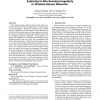Free Online Productivity Tools
i2Speak
i2Symbol
i2OCR
iTex2Img
iWeb2Print
iWeb2Shot
i2Type
iPdf2Split
iPdf2Merge
i2Bopomofo
i2Arabic
i2Style
i2Image
i2PDF
iLatex2Rtf
Sci2ools
TPDS
2010
2010
Exploring In-Situ Sensing Irregularity in Wireless Sensor Networks
The circular sensing model has been widely used to estimate performance of sensing applications in existing analysis and simulations. While this model provides valuable high-level guidelines, the quantitative results obtained may not reflect the true performance of these applications, due to the existence of obstacles and sensing irregularity introduced by insufficient hardware calibration. In this project, we design and implement two Sensing Area Modeling (SAM) techniques useful in the real world. They complement each other in the design space. P-SAM provides accurate sensing area models for individual nodes using controlled or monitored events, while V-SAM provides continuous sensing similarity models using natural events in an environment. With these two models, we pioneer an investigation of the impact of sensing irregularity on application performance, such as coverage scheduling. We evaluate SAM extensively in realworld settings, using three testbeds consisting of 40 MICAz mot...
| Added | 31 Jan 2011 |
| Updated | 31 Jan 2011 |
| Type | Journal |
| Year | 2010 |
| Where | TPDS |
| Authors | Joengmin Hwang, Tian He, Yongdae Kim |
Comments (0)

